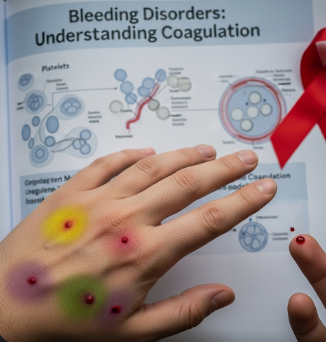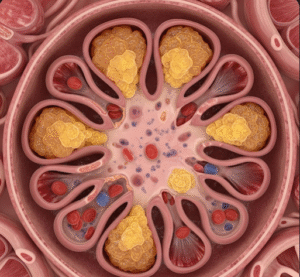Overview
Bleeding disorders are a group of conditions in which the body’s ability to form blood clots is impaired, leading to excessive or prolonged bleeding. These disorders can range from mild, easily managed conditions to life-threatening diseases that require ongoing medical care.
In Korea, advanced hematology departments, specialized clinics, and blood transfusion centers provide comprehensive management for bleeding disorders. Early diagnosis, personalized treatment plans, and preventive strategies have greatly improved the prognosis and quality of life for patients.
What are Bleeding Disorders?
Bleeding disorders occur when the blood clotting process is disrupted due to deficiencies in platelets, clotting factors, or blood vessel integrity. The main categories include:
- Hemophilia: Genetic disorders causing deficiency in clotting factors VIII (Hemophilia A) or IX (Hemophilia B)
- Von Willebrand Disease (VWD): Deficiency or dysfunction of von Willebrand factor, affecting platelet adhesion
- Platelet disorders: Low platelet counts (thrombocytopenia) or dysfunctional platelets
- Acquired bleeding disorders: Resulting from medications (anticoagulants), liver disease, vitamin K deficiency, or autoimmune conditions
Bleeding disorders may manifest at birth or develop later in life, depending on whether they are inherited or acquired.
Symptoms
Symptoms vary depending on the type and severity of the disorder:
- Excessive bruising: Even after minor bumps or injuries
- Prolonged bleeding: From cuts, surgical procedures, or dental work
- Frequent nosebleeds or gum bleeding
- Heavy menstrual bleeding (menorrhagia) in women
- Joint and muscle bleeding: Leading to pain, swelling, and reduced mobility, especially in hemophilia
- Blood in urine or stool
- Fatigue and anemia: Due to chronic blood loss
Severe cases can lead to internal bleeding, which may be life-threatening if untreated.
Causes
The causes of bleeding disorders include:
- Genetic mutations: Inherited deficiencies in clotting factors, such as hemophilia or VWD
- Autoimmune conditions: Antibodies that inhibit clotting factors
- Medications: Anticoagulants (warfarin, heparin), antiplatelet drugs
- Liver disease: Impaired production of clotting factors
- Nutritional deficiencies: Vitamin K deficiency affecting clotting
- Bone marrow disorders: Affect platelet production
Risk Factors
- Family history: Inherited bleeding disorders are more common in families with known mutations
- Gender: Hemophilia primarily affects males, whereas VWD can affect both genders
- Medications: Long-term anticoagulant or antiplatelet therapy
- Chronic diseases: Liver dysfunction, kidney disease, or autoimmune disorders
- Surgery or trauma: Unrecognized bleeding disorders can worsen bleeding during procedures
Complications
Complications from bleeding disorders can be severe and include:
- Internal bleeding: Into joints, muscles, or organs, leading to pain and tissue damage
- Anemia: Chronic blood loss causing fatigue and weakness
- Joint deformities: Repeated hemarthroses in hemophilia can cause permanent joint damage
- Excessive bleeding during surgery or childbirth
- Life-threatening hemorrhage: In severe cases or trauma
- Psychosocial impact: Anxiety, limited physical activity, and reduced quality of life
Prevention
While genetic bleeding disorders cannot be completely prevented, measures can reduce risks and complications:
- Genetic counseling: For families with a history of bleeding disorders
- Avoidance of trauma or high-risk activities: To prevent injury-related bleeding
- Careful medication management: Avoid unnecessary anticoagulants or antiplatelet drugs
- Vaccination and liver protection: Reduce risk of liver disease affecting clotting
- Early detection and monitoring: Regular blood tests and specialist consultations
Treatment Options in Korea
Diagnosis
Accurate diagnosis involves:
- Blood tests: Platelet counts, clotting factor levels, prothrombin time (PT), and activated partial thromboplastin time (aPTT)
- Genetic testing: Identifies mutations in hemophilia or VWD
- Platelet function tests: For suspected platelet disorders
- Medical history and physical examination: Family history, bleeding patterns, and prior incidents
Medical Management
Treatment depends on the type and severity of the disorder:
- Replacement therapy: Infusion of clotting factors for hemophilia or VWD
- Desmopressin (DDAVP): Stimulates release of von Willebrand factor in mild VWD
- Antifibrinolytic agents: Prevent breakdown of clots
- Platelet transfusions: For low platelet counts or dysfunctional platelets
- Medications: Vitamin K for deficiencies; careful use of anticoagulants
- Pain management and physiotherapy: For joint bleeds and mobility issues
Surgical and Supportive Care
- Surgical precautions: Preoperative clotting factor replacement to prevent bleeding
- Joint protection and rehabilitation: Prevent deformities from repeated bleeds
- Emergency care: Management of severe hemorrhage or trauma
- Patient education: Instruction on recognizing early bleeding signs and proper self-care
Prognosis
With proper management in Korea, most patients with bleeding disorders lead relatively normal lives:
- Regular factor replacement and preventive therapy reduce the risk of severe bleeding
- Early intervention for joint or organ bleeds prevents long-term complications
- Access to specialized hematology centers ensures prompt diagnosis, treatment, and monitoring
- Lifelong follow-up is essential for optimal outcomes and improved quality of life













